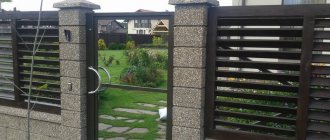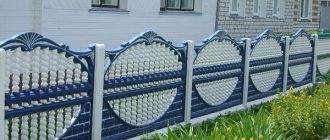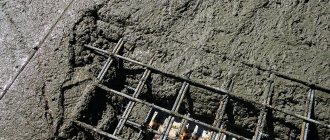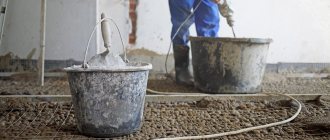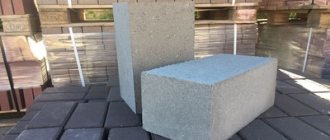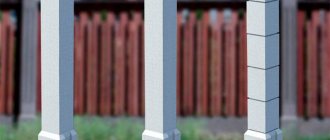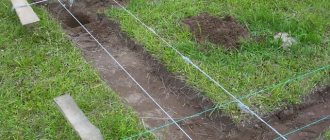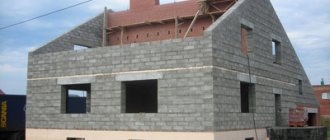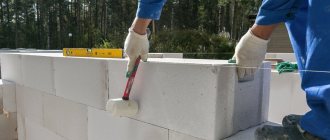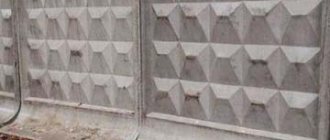No. 1. Pros and cons of concrete fences
The great popularity of fences made of concrete blocks and sections is due to their many advantages:
- strength;
- durability that reaches 100 years;
- resistance to fire, corrosion, negative temperatures and other negative external influences;
- installation of concrete blocks can be done with your own hands, but some skills will be required;
- appearance. The aesthetics of concrete fences have always suffered, so appearance was considered a disadvantage, but that’s all about monolithic sections. They were replaced by decorative concrete blocks and sections, sometimes called Eurofence. They quite accurately imitate the texture of natural stone and wood; they can be of any shade, solid or with decorative holes.
Among the main disadvantages:
- the need to build a solid foundation;
- relatively expensive, but if you take into account the durability, the price cannot be considered too high.
Wall masonry
Do-it-yourself laying of cinder blocks on a frozen foundation in the following order:
- A layer of waterproofing is laid on top of the foundation. The individual pieces are stacked with overlap.
- The outer blocks located between two adjacent pillars are laid on the cement mortar.
- A cord is stretched between the blocks, along which the first row is laid. If the whole block does not fit in a row, it is cut to the required size.
- This fills the entire first row within one section.
- The second row and all subsequent rows are laid out in the same way. The cord is consistently moved higher and higher.
- During the laying process, the verticality of the masonry is periodically checked using a plumb line and level.
- A layer of concrete mortar is applied on top of the last row of blocks to prevent moisture from getting between the blocks.
- Canopies made of galvanized metal are installed on top of the fence and individual posts. Their function is protective and decorative. Overhangs add a finishing touch to a cinder block fence.
- If necessary, lamps and other decorative elements are installed on the fence.
No. 2. Types of structures for creating concrete fences
To avoid confusion, let's look at the classification of concrete elements that are used to create fences:
- monolithic reinforced concrete sections of decent length and height, with a smooth, less often embossed (diamond-shaped) surface. Such sections weigh several tons, are mounted with special equipment, and are used for fencing industrial enterprises - they are not used in private construction;
- decorative concrete slabs (eurofence) are distinguished by a wide variety and are used for fencing dachas, country houses and private houses;
- decorative concrete blocks They are similar in size to gas blocks and foam blocks, allow you to build a fence as quickly and easily as possible, and are distinguished by the greatest variety of colors and textures.
The last two variants of concrete blocks have become widespread in private construction, and they will be discussed further.
No. 3. Decorative concrete slabs
Decorative concrete slabs are produced in a length of 2 m and a height of 55 cm, so the height of the fence can be adjusted at your discretion. As a rule, fences are erected from 2-4 sections stacked on top of each other. Such modules are produced by pouring concrete into molds, the variety of which is quite large. Sections can be blank and openwork, imitate sandstone, slate, brick , tiles , wood, and have various patterns and ornaments. There are even samples where concrete is combined with forged elements and wood. Fences built from such slabs are called Eurofence .
Concrete can be painted after it is cast into a mold, but it is better to choose products painted in the mass - they retain their original appearance much longer and do not scratch or fade. Different decorative concrete slabs can be combined with each other to create exclusive combinations. In addition, slabs with double-sided decorative coating are also produced - they are useful when it is important that the fence looks attractive on both sides.
Higher slabs are also produced, which in themselves are already a full-fledged section of the fence. They are not as diverse in terms of design and color, but still prettier than industrial monolithic sections, and they weigh less.
No. 4. Decorative concrete blocks for fence
Decorative concrete blocks are made by casting or vibropressing into molds. The blocks are small in size, due to which their installation is greatly simplified compared to large sections and even slabs and is somewhat reminiscent of ordinary brickwork. The length of such elements is about 30-50 cm , width - 15-25 cm, and height - 14-25 mm, the weight of more than one block is about 10-25 kg depending on the size and hollowness. Such elements are several times larger than the dimensions of a brick, which means that the work on installing the fence will be carried out much faster.
The external sides can accurately replicate the structure of brick, slate, natural stone, tiles and other noble materials, so a fence made from such blocks is indistinguishable in appearance from one built from brick or stone, but at the same time it is much cheaper, and durability is not inferior to them. The surface can be smooth - such fences also look good. Blocks can be painted en masse or after installation.
Concrete blocks are produced predominantly hollow, which makes them easier to transport and install, but this is not the main purpose of the voids. During installation, the holes in the blocks are filled with cement mortar and reinforced with reinforcement, making it possible to obtain a reliable and most durable structure. In fact, the blocks become permanent formwork.
Crushed stone or gravel are used as fillers for decorative fence blocks, but expanded clay or granite screenings can be used.
Main characteristics of the material
Cinder block is a building material made from sand, cement, lime and water. The pressing method is used in its production.
Sand-cement mortar with various fillers is poured into a special form: crushed stone, gravel, brick waste. The operational and decorative characteristics of the block depend on the filler.
Advantages and disadvantages of cinder block
The popularity of cinder blocks is due to the following advantages:
- Strength and durability combined with low cost.
- Ease of construction. Building a fence requires minimal masonry skills.
- Environmental friendliness. Cinder blocks are made from pure components that do not contain harmful substances.
- Ease. Cinder block is 2 times lighter than natural stone and brick of the same size.
The disadvantages of the material are its high hygroscopicity and low decorativeness. However, this disadvantage can be easily overcome by applying a special coating to the constructed fence.
No. 5. Decorative concrete blocks for fence posts
Theoretically, support posts for a concrete fence can be made from brick or other suitable materials, but it is much easier and faster to build fence posts from special blocks , which are made in exactly the same way as the fence elements. Pillar blocks also boast a variety of textures and colors; they are easy to match with the selected fence elements, especially since manufacturers’ collections, as a rule, have blocks for different purposes, but of similar design. Concrete pillar blocks today are used in the construction of fences made of corrugated sheets, wood, forging, picket fences and other materials, so they have become completely universal.
With concrete blocks for a fence, it makes the most sense to use concrete posts. They may vary in size, most often they are a square with a side of 25-37 cm, but there are also rectangular blocks. Empty internal space is used to accommodate reinforcement elements.
To protect the fence and its decoration, concrete post and fence covers , although they are sometimes replaced or supplemented with metal covers.
No. 6. Manufacturers of concrete blocks
When buying concrete blocks for a fence, you need to pay attention to the size and appearance - it all depends on taste, the dimensions of the fence and the style of the site; it is inappropriate to advise anything. Blocks that are almost identical in appearance can differ greatly in quality, and here a lot depends on the integrity of the manufacturer, whose name is a kind of guarantee of reliability.
Some of the largest manufacturers of decorative concrete blocks for fences are:
- LLC “4th Bastion” is a company from St. Petersburg, operating since 2001 and producing concrete blocks for fences and posts, post covers in a wide range. The company's products are sold outside the region;
- "Evrovazon" is another St. Petersburg company that produces blocks using the “washed concrete” technology, which involves adding granite, marble, quartz, and pebbles chips to the solution. The result is blocks that are indistinguishable in appearance from natural stone, as strong and durable as possible. In this way, all the necessary elements for the fence are produced. Delivery throughout the country;
- Smik HOUSE LLC is a Moscow company that provides a 3-year guarantee for its products. Delivery is carried out to all regions, installation is carried out if necessary. The products are of high quality, as evidenced by the relevant test reports. The range is wide;
- , member of the group has been operating since 2009 and provides a 5-year warranty on products. Manufactures various types of fences, incl. and concrete blocks. The range is small, but includes all the most popular options;
- Fortis LLC relies on the quality of raw materials, which is why the concrete elements are strong and durable. If necessary, the company produces individual elements for the fence according to the client’s sketches.
When purchasing, it also doesn’t hurt to personally inspect the blocks . They must have the most accurate geometry, a smooth surface without chips, foreign inclusions or cracks, and uniform coloring.
Tips for arranging supports
Along the perimeter of the future fence, you need to install stakes in place of the supports and pull the rope. The placement of pegs must be strictly aligned. The distance between the pillars is up to 3 m, and for heavy structures no more than 2.5 m. For extreme, corner supports, pipes of larger diameter are selected. This will ensure the stability of the structure before loading.
First you need to sequentially install the corner posts and check their height matching using a level. Twine is pulled from below and above between the pillars. It will help you position the intermediate supports evenly.
Installation will be more difficult if the height difference in the area is more than 250 mm. In this case, you need to install additional supports and arrange a stepped structure. In areas of the fence where it is planned to install a wicket or gate, it is necessary to install additional posts for greater reliability.
If you are faced with a groundwater problem, then you need to dig a trench or drill a hole deeper, i.e. lower relative to the water level. In this case, you will need to prepare a significantly larger volume of solution.
Experts also recommend constructing a high-quality drainage pad. Crushed stone with expanded clay is placed in the pits in a layer of at least 200 mm. Then a pillar is placed, and the gap between the pit is filled with crushed stone. But not completely, but with a shortfall of 150 mm. Concrete is poured from above the pillow to ground level.
You can install fencing on the territory of a country house yourself. To do this, you need to select supports that match the fence material, and then install them, following our simple instructions.
No. 7. Installation of concrete blocks
In principle, you can install a fence made of concrete blocks yourself, but for this it is better to have experience in arranging the foundation and laying walls. The main difficulty lies in preparing a reliable foundation.
The sequence of work when preparing the foundation is as follows:
- territory marking using pegs and rope. It is necessary to outline where exactly the fence will be located. You may have to coordinate this issue with your neighbors and relevant authorities. To simplify the work and obtain a perfectly level fence, pegs are driven in around the perimeter of the future fence and a rope is pulled along them;
- digging a trench . Its width should be twice the width of the future masonry plus another 40 cm. The depth depends on the type of soil: for non-heaving soil, you can dig a ditch 70 cm deep, in other cases it is better to make a trench 20 cm deeper than the soil freezing level;
- The bottom of the trench is well compacted, 10 cm of sand and crushed stone , each layer is watered and compacted. After this, you can install waterproofing - roofing felt will do. They line the walls and bottom of the trench;
- preparing a concrete solution from cement, crushed stone and sand in a ratio of 1:5:3 and water. Since you will need a lot of concrete, it is better to use a concrete mixer;
- concrete is poured onto the drainage with a layer of waterproofing in a layer of about 10 cm and after it hardens it is installed formwork made of boards, it is advisable to provide spacers. A frame made of reinforcement is placed in the formwork, which is knitted using welding or knitting wire. For reinforcement, steel rods with a diameter of 12 mm are best suited. About 4 longitudinal rods are used (depending on the width of the block), they are connected with transverse rods and vertical rods are made, a step of 10-20 cm. Vertical rods are released at 15 cm - they will go into the voids of the concrete blocks and will serve for a better connection between the foundation and the fence;
- At the locations of the pillars, pipes . If the location of the pillars was not clearly defined earlier, this can be done now. The first rack will be located at the very beginning of the frame. Now, pillar and fence blocks are laid parallel to the trench, taking into account the thickness of the seam. The length of the fence span is, as a rule, 3-4 m. The middle of the next support post will indicate the location of the post;
- pouring concrete into the formwork and thoroughly compacting it. Periodically, the solution can be moistened with water; the formwork is removed after a week;
- parts of the roofing material exposed to the surface are glued to the foundation with bitumen mastic;
- the distance between the walls of the trench and the concrete foundation is covered with earth.
This concludes the preparation of the foundation and the construction of the fence begins:
- work begins with the installation of pillar elements , for masonry they use ordinary cement mortar, the thickness of the seam is 1-1.5 cm. Every 2-4 rows they lay a reinforcing masonry mesh with an outlet that will go into the masonry of the fence;
- Concrete mortar is poured into the voids of the first blocks of the fence. Each new row is laid with a shift in relation to the previous one by a third or half - as when laying bricks. Verticality and horizontality are constantly checked with a level. It is advisable to lay every two rows mesh for greater structural strength. The masonry mortar is applied to the ends, bypassing the voids, do not forget about the vertical seams;
- when laying, it is better to take blocks from different batches and pallets in order to get the same appearance of the fence along its entire perimeter;
- excess solution must be removed promptly, avoiding the appearance of smudges and dirt on the blocks;
- if the fence has not yet been completed, it does not hurt to protect it in case of rain with plastic wrap. If water gets into the still fresh masonry mortar, efflorescence cannot be avoided;
- after installation is completed, the masonry can be treated with protective hydrophobic agents;
- All that remains is to install the covers for the post and fences.
When it comes to installing concrete slabs , the sequence of work is the same, except that special pillars with grooves are used for them, in which the slabs are attached. First, the first pillar is mounted, the lower section is inserted, and only then the second pillar is mounted so that the slab fits tightly into the grooves.
Manufacturing nuances
You can make blocks for fence posts yourself. To do this, you need to prepare the appropriate components, as well as forms. As for the components, it all depends on what effect the owner of the fenced area wants to achieve.
Mold for making decorative items
Recipes
There are several versions of the recipes. Most often, the mixture is made from Portland cement and pure sand in a ratio of 1:2.
Important! Plasticizer SP-1 is used as an additional substance that improves the properties of future blocks. It gives the material strength, increases its resistance to moisture and low temperatures, and also prevents the appearance of various defects on the surface.
Superplasticizer Poliplast SP-1
To reduce cement consumption, you can add fine gravel to the mixture, and in order for the material to look like natural stone, you can use marble chips or glass as texture substances when making a block.
Concrete fillers
Anyone who wants to have a fence in their dacha that is not monotonous gray, but some other color that is brighter, can add coloring pigments to the mixture.
Products painted with pigments for concrete
In order to make a block of the required size from the prepared mixture, you will need molds.
Mold for making blocks with a “Mosaic” pattern
You can also make them yourself. Moreover, there are several options for making molds. You can use any available means suitable for this, for example, old furniture. The rectangular shape can be created from sheet metal or from boards.
The principle of block manufacturing by molding
In order to decorate the block with some kind of pattern, you can simply make an insert of the desired type from metal. When the mold for the block is ready, you can start filling it with concrete mixture. It usually takes several days to dry. It is better not to rush and give more time for the mass to adhere tightly.
